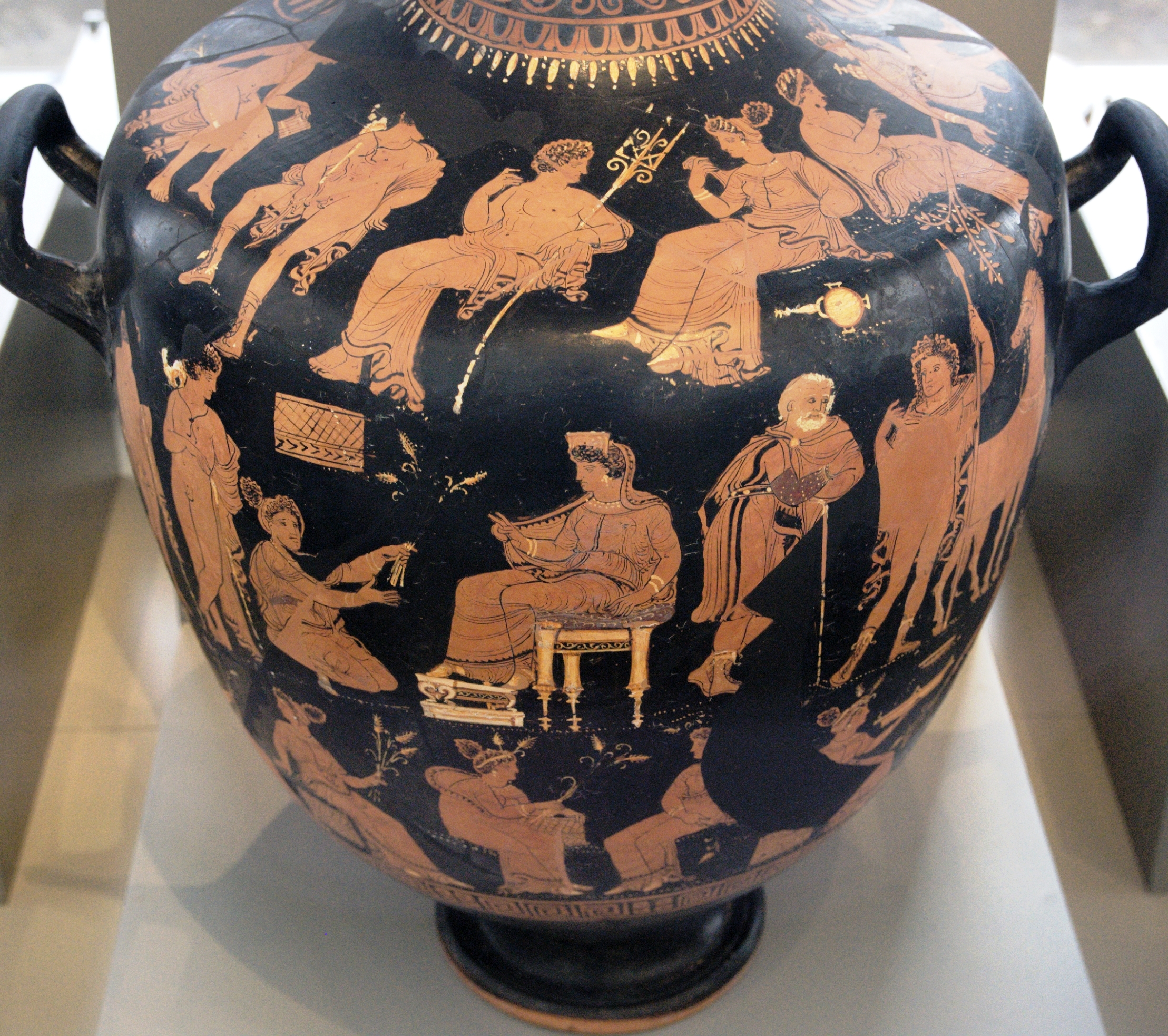Varrese Painter on:
[Wikipedia]
[Google]
[Amazon]
 The Varrese Painter was an Apulian
The Varrese Painter was an Apulian
Works at the British MuseumPelike at the Getty MuseumColumn-krater at the Metropolitan Museum of ArtAmphora sold at Christie's
{{DEFAULTSORT:Varrese Painter 4th-century BC deaths Ancient Greek vase painters Anonymous artists of antiquity People from Apulia 4th-century BC people Year of birth unknown
 The Varrese Painter was an Apulian
The Varrese Painter was an Apulian red-figure
Red-figure vase painting is one of the most important styles of figural Greek vase painting.
It developed in Athens around 520 BCE and remained in use until the late 3rd century BCE. It replaced the previously dominant style of black-figure va ...
vase painter
Ancient Greek pottery, due to its relative durability, comprises a large part of the archaeological record of ancient Greece, and since there is so much of it (over 100,000 painted vases are recorded in the Corpus vasorum antiquorum), it has ex ...
. His works are dated to the middle of the 4th century BC.
His conventional name is derived from the Varrese hypogeum
A hypogeum or hypogaeum (plural hypogea or hypogaea, pronounced ; literally meaning "underground", from Greek ''hypo'' (under) and ''ghê'' (earth)) is an underground temple or tomb.
Hypogea will often contain niches for cremated human rem ...
(a rock-cut grave complex) at Canosa di Puglia
Canosa di Puglia, generally known simply as Canosa ( nap, label= Canosino, Canaus), is a town and ''comune'' in the province of Barletta-Andria-Trani, Apulia, southern Italy. It is located between Bari and Foggia, on the northwestern edge of the ...
, which contained several vases painted by him. In total, over 200 known vases are attributed to him. Scholars consider him one of the most important representatives of his period. His influence extended beyond his immediate surroundings and beyond his own phase of activity, as far as the immediate predecessors of the Darius Painter
The Darius Painter was an Apulian vase painter and the most eminent representative at the end of the " Ornate Style" in South Italian red-figure vase painting. His works were produced between 340 and 320 BC.
The Darius Painter's conventional name ...
. A quarter of the vases attributed to him, including ''hydriai'', nestorids, '' loutrophoroi'' and a large ''oenochoe
An oenochoe, also spelled oinochoe ( grc, οἰνοχόη; from grc, οἶνος ''oînos'', "wine" and grc, χέω ''khéō'', "I pour," sense "wine-pourer"; plural ''oinochoai''; New Latin ''oenochoë,'' plural ''oenochoae,'' English plura ...
'' are of considerable size. The rest if his work is mainly on bell ''krater
A krater or crater ( grc-gre, , ''kratēr'', literally "mixing vessel") was a large two-handled shape of vase in Ancient Greek pottery and metalwork, mostly used for the mixing of wine with water.
Form and function
At a Greek symposium, krat ...
s'' and ''pelike
A pelike ( grc, πελίκη) is a one-piece ceramic container similar to an amphora
An amphora (; grc, ἀμφορεύς, ''amphoreús''; English plural: amphorae or amphoras) is a type of container with a pointed bottom and characterist ...
s''. Although he belongs to the tradition of the Ornate Style, his smaller vessels are often stylistically close to the Plain Style.
His pictorial repertoire is characterised by frequently repeated motifs. Four basic motifs have been identified:
*A naked youth, either standing with one arm covered by a garment, or seated on a folded cloth;
*A standing female figure, both legs clearly visible under her garment, one placed behind the other;
*A clothed woman, one of her feet standing on a higher level than the other, her upper body bent towards that foot, one arm resting on her thigh;
*A seated woman, placing one leg in front of the other.
The Varrese Painter's figures appear serious and sombre, their mouths are small and turned downwards. His women often wear their hair in a knot held by a white band. On his larger vases, especially when depicting funerary '' naiskoi'', he makes copious use of additional colours. His large vessels usually show mythological scenes. His smaller vases usually bear compositions of two or three figures on both sides, often including cloaked youths on the back.
The Varrese Painter's workshop also employed the Wolfenbüttel Painter; his influence has been noted not only on the predecessors of the Darius Painter
The Darius Painter was an Apulian vase painter and the most eminent representative at the end of the " Ornate Style" in South Italian red-figure vase painting. His works were produced between 340 and 320 BC.
The Darius Painter's conventional name ...
, but also on the Ginosa Painter, the Painter of Bari 12061
Painting is the practice of applying paint, pigment, color or other medium to a solid surface (called the "matrix" or "support"). The medium is commonly applied to the base with a brush, but other implements, such as knives, sponges, and ...
, the Metope Painter
In classical architecture, a metope (μετόπη) is a rectangular architectural element that fills the space between two triglyphs in a Doric frieze, which is a decorative band of alternating triglyphs and metopes above the architrave of a ...
, the Painter of Louvre MNB 1148
Painting is the practice of applying paint, pigment, color or other medium to a solid surface (called the "matrix" or "support"). The medium is commonly applied to the base with a brush, but other implements, such as knives, sponges, and ...
and the Chamay Painter.
Bibliography
* Arthur Dale Trendall. ''Rotfigurige Vasen aus Unteritalien und Sizilien. Ein Handbuch.'' von Zabern, Mainz 1991 (Kulturgeschichte der Antiken Welt Vol. 47), esp. p. 97-101 .External links
Works at the British Museum
{{DEFAULTSORT:Varrese Painter 4th-century BC deaths Ancient Greek vase painters Anonymous artists of antiquity People from Apulia 4th-century BC people Year of birth unknown